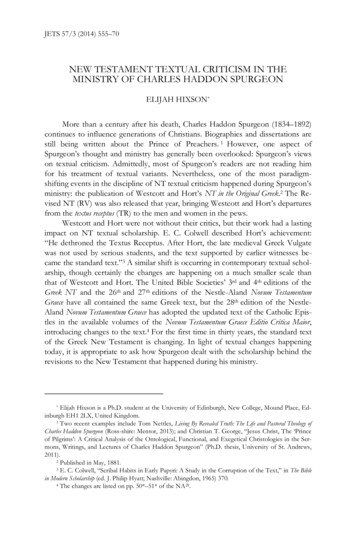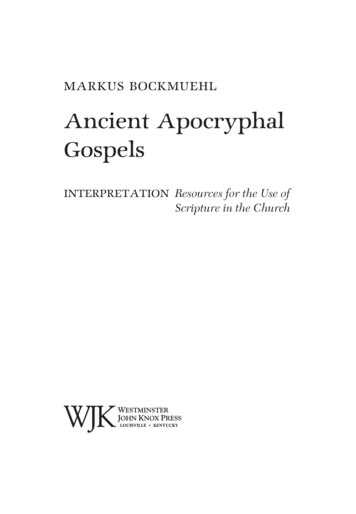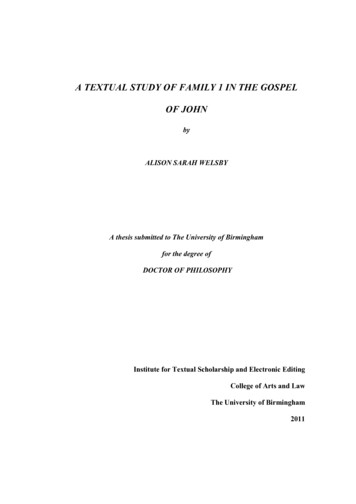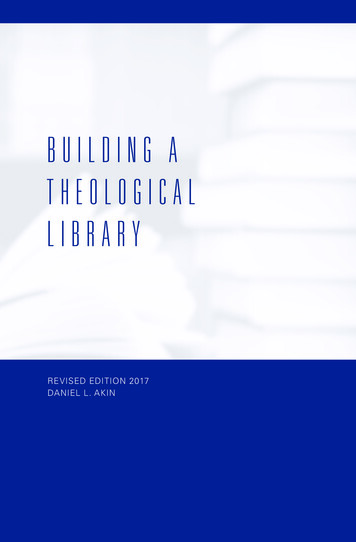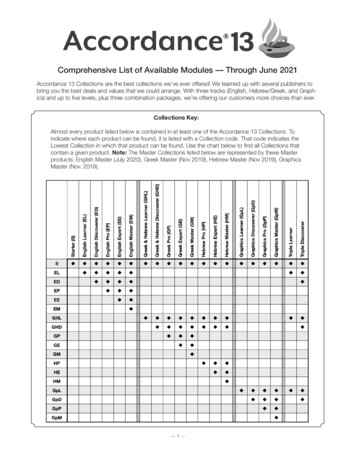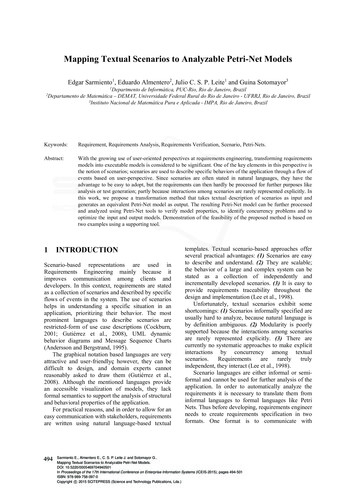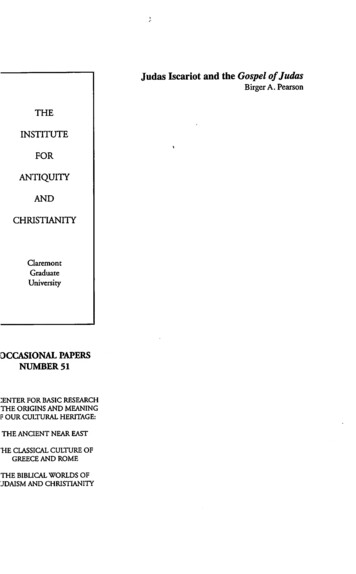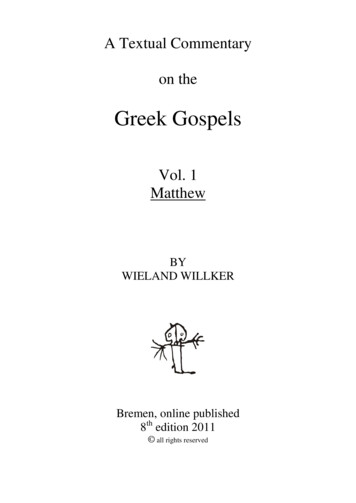
Transcription
A Textual Commentaryon theGreek GospelsVol. 1MatthewBYWIELAND WILLKERBremen, online published8th edition 2011 all rights reserved
Textual variantsin theGospel of MatthewResults from the variant evaluation:The best manuscripts of Mt:1. Primary ( best) witnesses:01, B, L18-28, Z, 085, sa2. Secondary ( good) witnesses:Q14-28, 0281, 3321-28, 3721-10, 892, vg, Co3. Tertiary:DByz, f1, 33, 70015-28, it, Sy-S, Sy-C[372, 2737, (2786) data :Q, f13, weak: (700, 1424)D, it, Sy-S, Sy-Cf1, 22, 652from 22:15A, C, L1-17, W, D, Q1-13, 28, 157, 565, 579, 7001-14, 1071, 1241,1424, SyP,HManuscripts with Lacuna: (noted also in the commentary)Lacunae of -26:22Lacunae of D:1:1-206:20-9:227:2-12Lacunae of L:4:22-5:1428:17-end27:11-4628:15-endZ/035 contents:N.B.! The lacunae of Z are not mentioned explicitly in this 23:3
Lacunae of Q:1:1-81:21-4:44:17-5:4Lacunae of Sy-S:6:10-8:316:15-17:1120:25-21:20Lacunae of Sy-C:8:23-10:3123:25-endLacunae of 1424:1:23-2:1628:8-endComplete NA analysis:To check if the selection of our variants is a good one, we compared the analysisby checking all variants in NA. An extensive analysis of all variants in NA27 gave:Best manuscripts are: 01, B, ZSecondary witnesses with good text are: C, D, f1, f13, 33, 892, Latadditionally Mt 1 - 14: WMt 14 - 28: L, QMt 15 - 21: 579, 700Mt 8 - 14: 1424Ranking:1. 01, B, Z2. D, L, Q, f1, 892, Lat3. C, W, f13, 33, 579, 700, 1424Clearly discernible Minority groups:1. D, Lat, (Sy)"Western"2. Q, f13 (700, f1, 1424)"Caesarean"This confirms the above results.
Family 1:The text of f1 is quite good in Matthew. Therefore it is good to have additionalwitnesses.Manuscript 652 is f1 in Mt from 22:15 on to the end.This has been discovered by Russell Champlin in 1964 (Family Pi in Matthew,Studies and Documents 24).Unfortunately 652 has not been catched by Text & Textwert. INTF has rightlybeen criticized for having used too few 'Teststellen' in Mt and Lk (only 7 after22:15). The result is that e.g. a manuscript like 652 slipped through and wasclassified as simply Byzantine.1582: This manuscript has been corrected by a later hand to the Byzantine text.I have decided to normally not record these corrections, but only in exceptionalcases.Additionally the T&T analysesfound the following minuscule manuscripts as especially noteworthy:37227372786"2" 7167522%20%15%16%7%10%10%15%These are comparable to:3338%14%W22%7%57916%4%22 and 1192 form a group with 48/56 (86%) agreement. 22 is close to f1 in Mt.372 and 2737 form a group with 59/64 (92%) agreement. All of these are notoutstanding, but only tertiary witnesses. 372 has some remarkable agreementswith B.
Codex Schoyen:We note in the following also the newly discovered middle-Egyptian CodexSchoyen manuscript 2650, dated early 4th CE. It will be listed as mae-2, againstmae-1 for the Codex Scheide. mae-2 has text for chapters 6, 7, 14-17, 22 and28.The Codex has a curious mixture of Western and Alexandrian readings combinedwith many singular readings.The nearest neighbors are: 01, B, 892, f1, D, it, Sy-SCompare extra file on this manuscript.arabMS: Sinai Ar. Parchment 8 28. 8th CE. It was among the new finds from1975. See NovT 50(2008)28-57.99 of the 327 variants (30%) are difficult to evaluate (Rating either "-" or "1?").Mt has 1068 verses. This means that we have- one significant variant every 3rd - 4th verse, and- one difficult variant every 12th verse.About 34 variants (10%) should be reconsidered in NA.Of the 327 variants noted only 42 (13%) have an umlaut in B (plus 8 insecurecases). There are 93 umlauts overall in Mt. This means that 51 of the 93 umlautsindicate rather minor (or unknown!) stuff.
TVU 1NA27 Matthew 1:6 VIessai.de. evge,nnhsen to.n Daui.d to.n basile,aÅevge,nnhsen to.n Solomw/na evk th/j tou/ Ouvri,ou(Daui.d de.BYZ Matthew 1:6 VIessai.de. evge,nnhsen to.n Daui.d to.n basile,aDaui.d de. o basileu.j evge,nnhsen to.n Solomw/na evk th/j tou/ Ouvri,ouByzC, K, P, L, W, D, 33, 157, 892, 1071, Maj, Lat, Sy-H, geotxtP1(3rd CE), 01, B, G, f1, f13, 579, 700, pc, g1, k, vgmss, Sy-S, Sy-C, Sy-P,Co, arm, Didomit previousto.n basile,a:700, bomsLacuna: D, QB: no umlautCompare:LXX Ruth 4:22kai. Wbhd evge,nnhsen to.n Iessai kai. Iessai evge,nnhsento.n Dauid ÞÞ to.n basile,aA/02Probably a repetition from 1:6a. The addition breaks the symmetry of theverses.Daui.d o basileu.j appears nowhere else in the NT, but 16 times in the LXX.Rating: 2? (NA probably original)
TVU 2Minority reading:NA27 Matthew 1:9VOzi,aj de. evge,nnhsen to.n VIwaqa,m( VIwaqa.m de.evge,nnhsen to.n VAca,z( VAca.z de. evge,nnhsen to.n Ezeki,an(VAca,j VAca,jtxt01, C, DLk, aur, g1*, k, q, mae-1, boms, WH01* reads 1st VAca,zB, L, W, Q, f1, f13, 33, 892, Maj, Lat, NA25, WeissD has a lacuna, but the (Matthean!) genealogy exists in Lk.Lacuna: D, 579B: no umlautVAca.z appears 38 times in the LXX, but VAca,j never.Rating: 2 (NA clearly original)
TVU 3Minority reading:NA27 Matthew 1:11VIwsi,aj de. evge,nnhsen Þ to.n VIeconi,an kai. tou.javdelfou.j auvtou/ evpi. th/j metoikesi,aj Babulw/nojÅT&T #1Þ to.n Iwakeim Iwakeim de. evge,nnhsen(D), M, U, Q, S, f1, 33, 1342, al168, Sy-H, Sy-Pal, geo, (IrLat), EpiphD (in Lk): touIeconiou tou Iwakeim tou Eliakeim tou IwseiaIr (2nd CE): "Joseph enim Joacim et Jechoniae filius ostenditur, quemadmodumet Matthaeus generationem ejus exponit."Epiphanius (4th CE, Pan. 1.8.1-4):For St. Matthew enumerated the generations (of Christ‘s genealogy) in three divisions, and saidthat there were fourteen generations from Abraham till David, fourteen from David till thecaptivity, and fourteen from the captivity until Christ. The first two counts are plain to be seenwith no lack of an item, for they include the times previous to Jechoniah. But we see that thethird count no longer has the total of fourteen generations found in a succession of names, butthe total of thirteen. This is because certain persons found a Jechoniah next to anotherJechoniah, and thought that the item had been duplicated. It was not a duplication however, buta distinct item. The son had been named "Jechoniah the son of Jechoniah" for his father. Byremoving the one name as though for scholarship's sake, certain persons ignorantly made thepromise (which is implied in the text) come short of its purpose with regard to the total of thefourteen names, and destroyed the regularity of the arrangement.Lacuna: DB: no umlautCompare:LXX 1 Chronicles 3:15kai. ui oi. Iwsia prwto,tokoj Iwanan o deu,terojIwakim o tri,toj Sedekia o te,tartoj Saloum16 kai. ui oi. IwakimIeconiaj ui o.j auvtou/ Sedekiaj ui o.j auvtou/And sons of Josiah: the first-born Johanan, the second Jehoiakim, the third Zedekiah, thefourth Shallum.16 And sons of Jehoiakim: Jeconiah his son, Zedekiah his son.According to Mt 1:17 there are 14 generations in each of the three sections(Hebdomadic principle, gr. "seventh"). Counting though, there are only 13 in thelast section. Several explanations have been put forward to overcome thisproblem.From early on it has been realized that Ieconiaj is not the son of Iwsia, butthe grandson. Compare 1.Chr 3:15. The (relevant) son is Iwakim, which had been
omitted by Mt. So, many scribes added the name here. Then we have 42generations in total, but 15 generations in the second section and still only 13 inthe last. It is possible to take Ieconiaj with the third section, which give 14generations in each section. The only problem is that Mt counts up to thedeportation to Babylon, which includes Ieconiaj into the second section.Either the name has been omitted to make the passage fit to 14 generations(unlikely), or it has been added to make it consistent with Chronicles, ignoringthe number of generations (more probable).Willoughby C. Allen (ICC Com. Mt 1912) suggests that VIeconi,an is a corruptionfor Iwakim and that VIeconi,an is included into the avdelfou.j auvtou/. Thisovercomes the discrepancy with the genealogy in 1. oseph/MaryJesusalternative:1. Abraham2. Isaac3. Jacob4. Judah5. Perez6. Hezron7. Aram8. Aminadab9. Nahshon10. Salmon11. Boaz12. Obed13. Jesse14. Jesus
For the D reading compare:2. Chr 36:4 The king of Egypt made his brother Eliakim king over Judah and Jerusalem, andchanged his name to Jehoiakim.So, Eliakim is just another name for Iwakim. Perhaps a marginal gloss thatfound its way into the text?D also adds three other names, compare discussion of D's genealogy in Lk.Rating: 2? (NA probably original)External Rating: 2 (NA clearly original)(after weighting the witnesses)
TVU 4Minority reading:NA27 Matthew 1:16 VIakw.bde. evge,nnhsen to.n VIwsh.fto.n a;ndra Mari,aj( evx h-j evgennh,qh VIhsou/j o lego,menoj cristo,jT&T #2to.n a;ndra Mari,aj( evx h-j evgennh,qhf1, pc12o lego,menoj cristo,jVIwsh.f de. evge,nnhsen to.n a;ndra Mari,aj( evx h-j evgennh,qh VIhsou/j o lego,menoj cristo,j2670w- mnhsteuqei,saparqe,noj Mari,am evge,nnhsen VIhsou/n to.nlego,menon cristo,nD?, Q, f13, L547, it(a, b, c, d, g1, k, q)"to whom, being betrothed, a virgin Maria bore Jesus"to.n a;ndra Mari,aj(w- mnhsteuqei,sa h n Mari,am parqe,noj h] e;teken VIhsou/j Cristo,jSy-C, arm"the husband of Mary, to whom was betrothed a virgin Maria, who bore Jesus"VIwsh.f(w- mnhsteuqei,sa h n Mari,am parqe,noj( evge,nnhsen VIhsou/n to.nlego,menon cristo,nSy-S"Joseph, to whom was betrothed a virgin Maria, begat Jesus"VIwsh.f de.( w- evmnhsteu,qh h n parqe,noj Mari,am( evge,nnhsen VIhsou/nto.n lego,menon cristo,nvon Soden (!)txtP1(3rd CE), 01, B, C, K, P, L, W, (f1), 33, 579, 892, Maj,Lat (aur, f, ff1, vg), Sy-P, Sy-H, Co
Latin:cui desponsata virgo Maria genuit Iesumcui desponsata virgo Maria peperit Christum Iesumcui desponsataMaria genuit Iesumcui desponsata virgo Maria, Maria autem genuit Iesumcui desponsata erat virgo Maria, virgo autem Maria genuit Iesumvirum Mariae de qua natus est Iesus ( txt)a, g1, kdqcbaur, f, ff1, vgLacuna: D (d is extant!)B: no umlautCompare:NA27 Matthew 1:18Tou/ de. VIhsou/ Cristou/ h ge,nesij ou[twj h nÅmnhsteuqei,shj th/j mhtro.j auvtou/ Mari,aj tw/ VIwsh,f( pri.n h'sunelqei/n auvtou.j eu re,qh evn gastri. e;cousa evk pneu,matoj a gi,ouÅVIwsh.f de. o avnh.r auvth/j( di,kaioj w'n kai. mh. qe,lwnauvth.n deigmati,sai( evboulh,qh la,qra avpolu/sai auvth,nÅSy-C, Tatian:VIwsh.f de. avnh.rdi,kaioj w'nNA27 Matthew 1:19This verse is famous for the "heretical" Sy-S reading which indicates Joseph asJesus father! It is probably a translation/comprehension error, originating fromthe Q, f13 reading, which is awkward, because the subject of evge,nnhsen is notimmediately clear. The Sy-S reading tries to continue the pattern from theprevious verses. P. Williams notes that from a grammatical/syntactical point ofview the Syriac translator had to provide a subject for evge,nnhsen VIhsou/n.Otherwise the sentence is ambiguous, leaving open even the possibility thatJakob was Jesus father. The scribe chose for whatever reason Joseph assubject and not Maria.Compare Streeter "Four Gospels", p. 87:"To me the reading of Sy-S looks as if it was translated from a Greekmanuscript of the Q, f13 type in which by accident the name VIwsh.f has beenwritten twice. The reading of Sy-C will then be explained as one among manyother attempts to correct this manuscript by a manuscript of the D type."Burkitt (Evangelion Da-Mepharreshe II, p. 262-4):"But the reading of S itself I have come to regard as nothing more than aparaphrase of the reading of the Ferrar group, the Syriac translator taking w- to refer to evge,nnhsen as well as to mnhsteuqei,sa."
Compare also the discussion by Bruce Metzger in:"The text of Mt 1:16" in "Studies in the NT and Early Christian Literature",Festschrift Allen P. Wikgren, Leiden 1972, p. 16-24Metzger discusses several references from the apocryphal literature allegedlysupporting the Sy-S reading, but he concludes: "there is no evidence thatreading (3) [ Sy-S] ever existed in a Greek manuscript of the First Gospel. Itarose either as a paraphrase of reading (2) [ Q, f13] – this was Burkitt's view –or as a purely mechanical imitation of the preceding pattern in the genealogy."Pete Williams also doubts that Sy-S represents an independent reading:"Thus S's reading, as reconstructed by NA27, differs formally in only threerespects from that of Q f13. The word order difference is normal translationprocedure, the addition of the subject would be obligatory, and the presenceof h n has long been doubted. Parsimony suggests that, though belief in aspecial reading of S has been widespread in modern scholarship, it should beabandoned unless new evidence is produced. (Again, it should be stressedthat NA27 is at the better end of the methodological spectrum in handlingsuch a variant. Von Soden, on the other hand, introduced an imaginary Greekreconstruction based on S into his main text.)"P. Williams "Early Syriac Translation Technique and the textual criticism of the GreekGospels", Gorgias Press, 2004, p. 240-44.So, to conclude, one can probably add Sy-S as a witness to the Q, f13 reading.The origin of the [Q, f13, Old Latin] reading was possibly motivated by theproblematic phrase to.n a;ndra Mari,aj. It appears possible that the readingwas originally a Latin-only reading. The text of Q, f13 then is a back-translationfrom the Old Latin. (But it is of course also possible that the reading alreadyexisted in the Vorlage of the Old Latin.) We should note that the Greek part ofD is not extant, but the Latin part is, which reads the Q et al. reading. It istherefore quite certain that D read this, too! It is a characteristic "Western"variant.Note a similar change in 1:19 by Sy-C!The Sy-C reading appears to be a conflation of the Old Latin reading and the txtreading.The Diatessaron lacked the genealogies, as far as we know, but it would beinteresting to know what Aphraates (Homilies) reads here exactly, because hehas the same strange genealogy as the one given in D. Compare Lk.
Stemma:txtOLatSy-SQ, f13txtSy-C, armIt must be noted that on internal arguments alone, the Sy-S reading is certainlydogmatically the harder one. Claiming Joseph to be Jesus father isobjectionable. Then the other readings would be attempts to overcome thisdifficulty.In general it should be noted that evge,nnhsen throughout the genealogydenotes legal, not physical descent.The reading of 2670 is funny.There is a marginal note on this verse in S/028 (from Swanson):Matqan o iereuj en Bhqleem genna qugateraj treijÇ Marian( Sobbh(Annan)h Maria genna Salwmhn thn maian)h Sobbh genna thn Elisabet)h de Anna thn agian qko n ¿qeotokon mother of GodÀwj einai thn Elisabet kai thn agian Marian kai Salwmhn thnmaian ek triwn adelfwn qhliwn (qh/luj, women).ton de prodromon (forerunner) kai thn Salwmhn thn gunaika Iwshfduo adelfwn arenwn) (arsenwn?)o Baraciaj genna ton Zacarian kai ton Aggaion( outoj th¿nÀiw ¿annhnÀ( outoj thn Salwmhn thn gunaika Iwshf tou tektonoj)o de Iwshf ix authj genna Iakwbon( Simwna( Ioudan( Iwsh( Esqhr(Marian)Mattan (Mt 1:15), the priest in Bethlehem, begat three daughters: Maria, Sobbe, Anna.Maria gave birth to Salome, the midwife.Sobbe gave birth to Elisabeth.But Anna (gave birth to) the holy mother of God.So are Elisabeth and the holy Maria and Salome the midwife from three sisters (lit. femalebrothers).But the forerunner and Salome the wife of Joseph are from two male brothers:Barachias begat Zacharias and Haggai, the former (then) Johannes, the latter Salome, the wifeof Joseph, the carpenter.But Joseph with her begat Jakobus, Simon, Judas, Jose, Esther, Maria.
It might be interesting to identify the earliest source of this text. S waswritten in the year 949. The text shows certain agreements with theProtogospel of James (Zacharias father of John, a Salome appears, Anna as Maria'smother).Compare:A. Martin "Matthieu 1:16 dans le palimpseste Syriaque du Sinai" FilologíaNeotestamentaria 15 (2002) 87-94 [has a "living text" approach]Rating: 2 (NA clearly original)
TVU 5Minority reading:NA27 Matthew 1:18Tou/ de. VIhsou/ Cristou/ h ge,nesij ou[twj h nÅCristou/ VIhsou/B, Or1/2, Jerome, Weiss, WHmgCristou/christipc, Latt, Sy-S, Sy-C, pers/arabmss, IrLat, DiatessSy,Jerome, AugWH have VIhsou/ in brackets.d ( D?)VIhsou/W, pc, pers/arabmssP1(3rd CE) reads txt.D has a lacuna, but d has "christi" so it is quite probable that D read this too.The Origen quote is doubtful, as Tregelles (Account., 1854, p. 189) notes: "Thepassage occurs in Jerome's Latin translation of Origen's 28th Homily on St.Luke, where the words are, 'Christi autem Jesu generatio sic erat.' This israther doubtful ground for citing Origen's authority, especially as in the Greekfragments of this very homily we find the common reading."According to T. Baarda (Lille Colloq. 2000) the reading of the Syriac Diatessaron(Ephrem) is: "The birth of Christ thus was". McCarthy gives it as "The birth ofthe Messiah took place as follows." The Arabic Diatessaron has "the birth ofJesus the Messiah".Lacuna: DB: no umlautCompare previous verse 17:NA27 Matthew 1:17 . e[wj tou/Cristou/ geneai. dekate,ssarejÅCompare:NA27 Matthew 1:1 Bi,bloj gene,sewj VIhsou/ Cristou/ ui ou/ Daui.dNA27 Matthew 11:2 O de. VIwa,nnhj avkou,saj evn tw/ desmwthri,w ta.e;rgatou/ Cristou/ pe,myaj dia. tw/n maqhtw/n auvtou/NA Mark 1:1 VArch. tou/ euvaggeli,ou VIhsou/ Cristou/ Îui ou/ qeou/ÐÅNA27 John 1:17 h ca,rij kai. h avlh,qeia dia. VIhsou/ Cristou/ evge,netoÅNA27 John 17:3 au[th de, evstin h aivw,nioj zwh. i[na ginw,skwsin se. to.nmo,non avlhqino.n qeo.n kai. o]n avpe,steilaj VIhsou/n Cristo,nÅ27
Compare also:NA27 Matthew 2:1 Tou/de. VIhsou/ gennhqe,ntoj evn Bhqle,em th/j VIoudai,ajVIhsou/ Cristou/ W, 346, pcNA27 Matthew 16:20 o[ti auvto,j evstin o cristo,jÅBYZ Matthew 16:20 o[ti auvto,j evstin VIhsou/j o cristo,jByz01C2, C, (D), K, W, f13a,c, 892, Maj, Lat, Sy-H, mae-1 2, botxt01*, B, L, D, Q, P, f1, f13b, 28, 565, 700, 1342, 1424, 1675, al,it, vgmss, Sy-C, Sy-P, sa, OrNA27 Matthew 16:21"Jesus Christ""Christ Jesus"VApo. to,te h;rxato o VIhsou/j deiknu,ein toi/j maqhtai/VIhsou/j Cristo,j01*, B*, samss, mae-1, boGospels5-Acts/Epistles13095In only very few of the cases an article has been applied to the term! to.ncristo.n VIhsou/n appears 3 times in Acts and once in Col 2:6. The orderVIhsou/j Cristo,j with the article appears nowhere else. Ehrman (OrthodoxCorruption, p. 173, note 96) writes: "Against this it should be noted that thewording of the entire clause is peculiar."The B reading is perhaps a conformation to Pauline usage.It has been suggested that the omission of "Jesus" is not simply an accidentalerror, but that it was deliberate. That this was the Genesis of **Christ**, notjust Jesus.Unfortunately D has a lacuna here.Regarding the Persian/Arabian versions, it is possible that they have beentranslated from Syriac (K. Lake, Text of the NT, notes: "traces of Caesareanreadings").Metzger suggests that the Western reading might be a conformation to theprevious verse 17. Zahn argues the reverse, that verse 17 shows the correctform and that verse 18 is corrupted.Ehrman writes: "Perhaps the best way to resolve the problems of both sequenceand terminology is to observe that the clause provides the transition betweenthe genealogy of verses 2-17 and the birth narrative of verses 18-25. Thearticle, then, serves as a weak relative whose antecedent is the subject of thepreceding pericope (VIhsou/ Cristou/, v.1).
"We know that this verse was important for orthodox heresiologists: they quoteit explicitly to confute Gnostic Christologies that separate Jesus from theChrist. Irenaeus in particular accrues some significant mileage from theWestern reading: 'The birth of Christ occurred in this way.' Irenaeus arguesthat because the text speaks specifically of the birth 'of Christ', it directlyconfutes those who 'assert that Jesus was he who was born of Mary but thatChrist was he who descended from above' (Adv. haer. III, 16:2). Thus theshorter text proved particularly amendable for the proto-orthodox in theirstruggles against Gnostic Christologies: Mary's infant was the Christ."". the change was made some time earlier in the second century by an orthodoxscribe who shared Irenaeus' concern to emphasize against the separationiststhat it was precisely the Christ who was born of Mary." (Ehrman, p. 138f.)Zahn (Com. Mat) thinks to the contrary that the Western reading is original. Hesays that the phrase tou/ de. Cristou/ h ge,nesij was striking as a note forthe birth of a child with the name Jesus. The addition of "Jesus" is only natural.But the resulting style is bad. Therefore the change of B et al. tou/ de.Cristou/ fits Matthean style (Mt 11:2).Compare 16:20,21 below.Rating: 2 (NA clearly original)
TVU 6Minority reading:NA27 Matthew 1:22tou/to de. o[lon ge,gonen i[na plhrwqh/ to. r hqe.n u po.kuri,ou dia. tou/ profh,tou le,gontoj\dia. VHsai ou tou/ profh,touD, pc, it, vgmss, Sy-S, Sy-C, Sy-H, Sy-Pal, sams, arm, DiatessSy, IrLatSy-C has: dia. sto,matoj VHsai ou tou/ profh,touk, vg do NOT read VHsai ou !Legg lists 1582*vid for this reading too! From the film nothing clearly can beseen. There possibly may be some correction, but what originally has beenwritten cannot be discerned. The script is the original scribe.According to T. Baarda (Lille Colloq. 2000) the reading of the Syriac Diatessaron(Ephrem) is: " . Isaiah . who said:" McCarthy gives it as "listen to Isaiah whosaid," The Arabic Diatessaron has "through the prophet".Lacuna: QB: no umlautCompare:NA27 Mark 1:2BYZ Mark 1:2Kaqw.j ge,graptai evn tw/ VHsai a tw/ profh,th \ Wj ge,graptai evn toi/j profh,taij(Also:NA27 Matthew 13:35to. r hqe.n dia. tou/ profh,tou le,gontoj\dia. VHsai ou tou/ profh,tou 01*, Q, f1, f13, 33, pc(in this case the attribution is wrong!)ivdou. h parqe,noj evn gastri. e[xei kai. te,xetai ui o,n kai.kale,seij to. o;noma auvtou/ EmmanouhlLXX Isaiah 7:14Quite certainly a secondary addition. There is no reason for an omission.Rating: 2 (NA clearly original)
TVU 7Minority reading:NA27 Matthew 1:23ivdou. h parqe,noj evn gastri. e[xei kai. te,xetai ui o,n(kai. kale,sousin to. o;noma auvtou/ VEmmanouh,l(kale,seijvocabitD, pc, d, ff1, bomss, Or, EusSwanson adds: 2*Lacuna: Q, 1424B: umlaut (1236 A 6 L)ui o,n( kai. kale,sousinParallel:LXX Isaiah 7:14 ivdou.h parqe,noj evn gastri. e[xei kai. te,xetai ui o,nkai. kale,seij to. o;noma auvtou/ Emmanouhlkale,sousin LXX-mssCompare context:NA27 Matthew 1:21te,xetai de. ui o,n( kai. kale,seij to. o;noma auvtou/VIhsou/n\ auvto.j ga.r sw,sei to.n lao.n auvtou/ avpo. tw/n a martiw/n auvtw/nÅClearly a harmonization to Isaiah and/or context. The singular fits better toverse 21.Rating: 2 (NA clearly original)
TVU 8Minority reading:NA27 Matthew 1:25kai. ouvk evgi,nwsken auvth.n e[wj ou- e;teken ui o,n\ kai.evka,lesen to. o;noma auvtou/ VIhsou/nÅomit: k, Sy-SSy-C has the words, basically:"and chastily lived with her until she bare the son."According to T. Baarda (Lille Colloq. 2000) the reading of the Syriac Diatessaron(Ephrem) is: "[and?] chastily he lived with her" McCarthy has this also. Ephremhas the text three times.Lacuna: Q, 1424B: no umlautIs it probable that the words have been omitted due to h.t. (OU – OU). If theou- is expressed in the versions is not clear. Compare next variant.Zahn (Com. Mat) suggests that perhaps from the negation of marital relationsbefore the birth disagreeable conclusions for the time after the birth havebeen drawn.Rating: 2? (NA probably original)
TVU 9Minority reading:NA27 Matthew 1:25 kai.ouvk evgi,nwsken auvth.n e[wj ou- e;tekenui o,n\ kai. evka,lesen to. o;noma auvtou/ VIhsou/nÅomitou-:B*, 1042S*, WeissNA25, WH both have it in bracketsB: ou- was added in minuscule script in the left margin (p. 1236 A 17), acc. toTischendorf by B3.Lacuna: Q, 1424B: no umlautCompare:NA27 Matthew 2:9paidi,onÅproh/gen auvtou,j( e[wj evlqw.n evsta,qh evpa,nw ou- h n to.avmh.n ga.r le,gw u mi/n\ e[wj a'n pare,lqh o ouvrano.j kai.h gh/( ivw/ta e]n h' mi,a kerai,a ouv mh. pare,lqh avpo. tou/ no,mou( e[wj a'npa,nta ge,nhtaiÅomit 1. a'n:13omit 2. a'n: B*, L2211, pc27NA Matthew 5:25 i;sqi euvnow/n tw/ avntidi,kw sou tacu,( e[wj o[tou ei metVauvtou/ evn th/ o dw/ (e[wj ou- 124, 788( f13), 2827NA Matthew 5:26 avmh.n le,gw soi( ouv mh. evxe,lqh j evkei/qen( e[wj a'navpodw/ j to.n e;scaton kodra,nthnÅe[wj ou- L, W, 1424e[wj3327NA Matthew 10:23 ouv mh. tele,shte ta.j po,leij tou/ VIsrah.l e[wj a'n e;lqh o ui o.j tou/ avnqrw,pouÅomit a'n: 01*, B, pc27NA Matthew 12:20 ka,lamon suntetrimme,non ouv katea,xei kai. li,nontufo,menon ouv sbe,sei( e[wj a'n evkba,lh eivj ni/koj th.n kri,sinÅe[wjL, 70027NA Matthew 13:33 h]n labou/sa gunh. evne,kruyen eivj avleu,rou sa,ta tri,ae[wj ou- evzumw,qh o[lonÅNA27 Matthew 14:22 kai. proa,gein auvto.n eivj to. pe,ran( e[wj ou- avpolu,sh tou.j o;cloujÅNA27 Matthew 17:9 mhdeni. ei;phte to. o[rama e[wj ou- o ui o.j tou/ avnqrw,pouevk nekrw/n evgerqh/ ÅNA27 Matthew 5:18
o de. ouvk h;qelen avlla. avpelqw.n e;balen auvto.n eivjfulakh.n e[wj avpodw/ to. ovfeilo,menonÅe[wj01, B, C, L, 892e[wj ou- D, K, P, W, Q, f1, f13, 33, 157, 579, Maj27NA Matthew 18:34 kai. ovrgisqei.j o ku,rioj auvtou/ pare,dwken auvto.ntoi/j basanistai/j e[wj ou- avpodw/ pa/n to. ovfeilo,menonÅomit ou-: B, 579vid, 892, pcNA27 Matthew 24:34 avmh.n le,gw u mi/n o[ti ouv mh. pare,lqh h genea. au[the[wj a'n pa,nta tau/ta ge,nhtaiÅomit a'n: 01, 1241, pce[wj ou- 15727NA Matthew 24:39 kai. ouvk e;gnwsan e[wj h lqen o kataklusmo.j kai.h ren a[pantaj( ou[twj e;stai Îkai.Ð h parousi,a tou/ ui ou/ tou/ avnqrw,pouÅe[wj ou- D, 33, 15727NAMatthew 26:36 kaqi,sate auvtou/ e[wj Îou-Ð avpelqw.n evkei/proseu,xwmaiÅe[wj a'nD, K, P, L, W, D, Q, f1, f13, 157, 565, ale[wj01, C, 0281, 28, 33, 700, 892, 1424, pce[wj ou- a'n P53vid, A, pcNA27 Matthew 18:30txtB, 067, 124, 579, 1071, MajPossibly the ou- was unintelligible to the scribe or it was simply an oversight.Weiss argues (Textkritik, p. 95) that e[wj alone is rare and that there is atendency to insert the fuller form (e[wj ou-, o[tou or a'n, compare Mt 18:30).Note that in 5:18, 10:23, 18:30, 18:34 B omits, too, but in 26:36 it preserves italmost exclusively.Rating: 2 (NA clearly original)
TVU 10NA27 Matthew 1:25 kai.ouvk evgi,nwsken auvth.n e[wj ou- e;tekenui o,n\ kai. evka,lesen to. o;noma auvtou/ VIhsou/nÅBYZ Matthew 1:25 kai.ouvk evgi,nwsken auvth.n e[wj ou- e;tekento.n ui o,n auvth/j to.n prwto,tokon\ kai. evka,lesen to. o;noma auvtou/ VIhsou/T&T #4ByzC, D, L, W, D, 087, 124 f13a,c, 892, 1071, Maj,aur, f, ff1, vg, Sy-P, Sy-H, (Diatess), Basil(4th CE)Variant: L, D*, d, q: to.n ui o,n\to.n prwto,tokontxt01, B, Zvid, 071vid, f1, 788( f13), 33, 1192, it, Sy-S, Sy-C, mae-1, (sa, bo)to.n ui o,nboui o,n auvth/j 1182, saauvtw/ ui o,nSy-SAccording to T. Baarda (Lille Colloq. 2000) the reading of the Syriac Diatessaron(Ephrem) is: "until she bare her first-born" (omitting "son"). McCarthy has "Untilshe gave birth to her First-Born". The Arabic Diatessaron has "until she broughtforth her firstborn son".Lacuna: Q, 1424B: no umlautParallel:NA27 Luke 2:7 kai.e;teken to.n ui o.n auvth/j to.n prwto,tokonomit to.n prwto,tokon: WCompare LXX:LXX 2 Samuel 11:27ui o,nkai. evgenh,qh auvtw/ eivj gunai/ka kai. e;teken auvtw/ kai. evporeu,qh kai. e;laben th.n Gomer qugate,ra Debhlaimkai. sune,laben kai. e;teken auvtw/ ui o,nLXX Hosea 1:3Clearly a harmonization to Lk. There is no reason to omit this important clause.T. Baarda gives the following discussion (Lille Colloq. 2000):"As a consequence one might conjecture that in early textual history there weretwo rival readings: (1) ui o,n and (2) auvth/j to.n prwto,tokon. Perhaps we may goeven further and posit the view that the latter reading 'her first-born' was
original and corrected into 'a son'. For the conclusion that might be drawn fromthe word 'first-born' is that Mary had other sons, a view that was not verywelcome in the church.". (compare complete discussion, p. 131 ff.)Baarda seems to be unaware of the Lukan parallel.Note that W (which is Alexandrian in this part of Lk) omitsfor no apparent reason (doctrinal?).Rating: 2 (NA clearly original)to.n prwto,tokon
TVU 11Minority reading:NA27 Matthew 2:11kai. evlqo,ntej eivj th.n oivki,an ei don to. paidi,on meta.Mari,aj th/j mhtro.j auvtou/(eu-ron2C, 474, al, Lat(aur, b, c, ff1, g1, vg), TRinveneruntLegg notes 892 for this reading, probably in error (it's not noted in Harris'collation, JBL).a, d, f, k, q read txt ( viderunt).Lacuna: Q, 1424B: no umlautCompare:NA27 Mark 7:30kai. avpelqou/sa eivj to.n oi kon auvth/j eu-ren to. paidi,onbeblhme,non evpi. th.n kli,nhn kai. to. daimo,nion evxelhluqo,jÅProbably from the Latin.Rating: 2 (NA clearly original)
TVU 12Minority reading:NA27 Matthew 2:13VAnacwrhsa,ntwn de. auvtw/n Þ ivdou. a;ggeloj kuri,oufai,netai katV o;nar tw/ VIwsh.f le,gwn\ evgerqei.j para,labe to. paidi,onkai. th.n mhte,ra auvtou/ kai. feu/ge eivj Ai;gupton kai. i;sqi evkei/ e[wj a'nei;pw soi\ me,llei ga.r Hrw, dhj zhtei/n to. paidi,on tou/ avpole,sai auvto,ÅÞ eivj th.n cw,ran auvtw/nBkatV o;nar evfa,nhevfa,nh katV o;narB, WHmg,
The text of f1 is quite good in Matthew. Therefore it is good to have additional witnesses. Manuscript 652 is f1 in Mt from 22:15 on to the end. This has been discovered by Russell Champlin in 1964 (Family Pi in Matthew, Studies and Documents 24). Unfortunately 652 has

